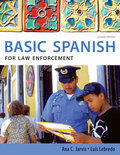
BASIC SPANISH FOR LAW ENFORCEMENT offers diversified business topics and vocabulary, technology-related terms, cultural notes, and activities on business culture and practices - correlated to the cultural notes - to check and reinforce students' business cross-cultural competency. INDICE: Lección preliminary. Conversaciones breves (Brief conversations). Structures from Basic Spanish Grammar: 1. Greetings and farewells. 2. The alphabet. 3. Gender and number 4. The definite and indefinite articles. 5. The present indicative of ser. 6. Cardinal numbers 0-39. Communication: Greetings, farewells, and introductions in personal and telephone interaction with other people. Lección 1. En una estación de policía. Structures from Basic Spanish Grammar: 1. Subject pronouns. 2. The present indicative of regular -ar verbs. 3.Interrogative and negative sentences. 4. Possession with de. 5. Cardinal numbers 40-299 and 300-1,000. 6. Forms and position of adjectives. 7. Telling time. Communication: On the phone - giving and receiving simple information, reporting an accident or a robbery. Lección 2. Con un agente hispano, en una callede la ciudad. Structures from Basic Spanish Grammar: 1. The present indicative of regular -er and -ir verbs. 2. Possession with de. 3. Possessive adjectives. Communication: Police work in the streets: asking for and giving directions, enforcing the use of a helmet, dealing with a girl walking alone in the streets. Lección 3. Con el agente Smith. Structures from Basic Spanish Grammar: 1. The irregular verbs ir, dar, and estar. 2. Uses of the verbs ser and estar.3. Ir a+ infinitive. 4. Contractions. Communication: Police work in the streets: dealing with gang members, arresting a thief. Lección 4. Llamadas telefónicas. Structures from Basic Spanish Grammar: 1. The irregular verbs tener and venir. 2. Expressions with tener. 3. Comparative forms. 4. Irregular comparative forms Communication: 911 calls: receiving emergency calls, describing people. Lección 5. Buenos vecinos. Structures from Basic Spanish Grammar: 1. Stem-changing verbs (e:ie). 2. The present progressive. 3. Some uses of the definite article. Communication: Neighborhood policing: helping to implement a neighborhood watch program. Lectura 1. Denunciando actividades sospechosasRepaso (Lecciones 1-5). Lección 6. El agente Chávez lee la advertencia Miranda. Structuresfrom Basic Spanish Grammar: 1. Stem-changing verbs (o:ue). 2. Affirmative andnegative expressions. 3. Direct object pronouns. Communication: Detaining suspects: reading the Miranda Warning, dealing with traffic violations and DUI. Lección 7. Problemas de la ciudad. Structures from Basic Spanish Grammar: 1. Stem-changing verbs (e:i). 2. Irregular first-person forms. 3. Indirect object pronouns. Communication: Investigating a crime: talking to victims, suspects, and witnesses, dealing with the victim of a health condition. Lección 8. Casos de maltrato de miembros de la familia. Structures from Basic Spanish Grammar: 1. Demonstrative adjectives and pronouns. 2. Special construction with gustar,doler, and hacer falta. 3. Direct and indirect object pronouns used together.Communication: Investigating domestic abuse: dealing with the victim and the abuser. Lección 9. La prueba de alcohol. Structures from Basic Spanish Grammar: 1. Possessive pronouns. 2. Command forms: Ud. and Uds. 3. Reflexive constructions. 4. Uses of object pronouns with command forms. Communication: Traffic police: stopping and interviewing drivers, administering a sobriety test, giving detailed directions. Lección 10. La policía investiga un robo. Structures from Basic Spanish Grammar: 1. The preterit of regular verbs. 2. The preterit ofser, ir and dar. 3. Uses of por and para Communication: Investigating a burglary: Interviewing victims and witnesses on location Lectura 2. Recomendacionespara prevenir el robo en las tiendas. Repaso (Lecciones 6-10). Lección 11. íMás robos! Structures from Basic Spanish Grammar: 1. Time expressions with hacer. 2. Irregular preterits. 3. The preterit of stem-changing verbs (e:i and o:u). 4. Command forms: tú. Communication: Investigating a burglary: Reporting a robbery, Interviewing victims at the police station. Lección 12. Con un agentede la sección de transito. Structures from Basic Spanish Grammar: 1. The imperfect tense. 2. The past progressive. 3. The preterit contrasted with the imperfect 4. En and a as equivalents of at. Communication: Traffic police: giving a ticket, issuing a warning, talking to a woman who left her baby in a locked car. Lección 13. Un accidente. Structures from Basic Spanish Grammar: 1. Hace meaning ago. 2. Changes in meaning with the imperfect and preterit of conocer,saber, and querer. Communication: Witnessing an accident: interviewing witnesses, talking to accident victims. Lección 14. Interrogatorios. Structures fromBasic Spanish Grammar: 1. The past participle. 2. The present perfect tense. 3. The past perfect (pluperfect) tense. Communication: Interrogating a suspects. Lección 15. Con la policía secreta. Structures from Basic Spanish Grammar: 1. The future tense. 2. The conditional tense. Communication: Working undercover: infiltrating a gang, arresting solicitors of prostitution. Lectura 3. Seguridad doméstica: Robos. Evite el robo de su automóvil. Repaso (Lecciones 11-15). Lección 16. En una celda de detención preventive. Structures from Basic Spanish Grammar: 1. The present subjunctive. 2. The subjunctive with verbs of volition. Communication: Arresting and booking suspects: following established procedure before placing an arrested person in a detention cell. Lección 17. Unamuchacha se escapa de su casa. Structures from Basic Spanish Grammar: 1. The subjunctive to express emotion. 2. The subjunctive with some impersonal expressions Communication: Investigating runaways: talking to runaways and parents Lección 18. Una violación. Structures from Basic Spanish Grammar: 1. The subjunctive to express doubt, disbelief, and denial. 2. The subjunctive to express indefiniteness and nonexistence Communication: Inv
- ISBN: 978-0-495-90253-9
- Editorial: Heinle & Heinle
- Encuadernacion: Rústica
- Páginas: 288
- Fecha Publicación: 26/02/2010
- Nº Volúmenes: 1
- Idioma: Inglés
